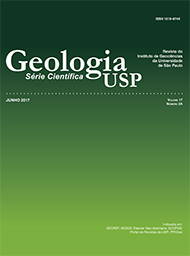Química mineral e condições de cristalização do plutão ediacarano Bom Jardim de Goiás, Província Tocantins, Centro Oeste do Brasil
DOI:
https://doi.org/10.11606/issn.2316-9095.v17-316Palavras-chave:
Província Tocantins, Ediacarano, Tonalitos, Geotermobarometria.Resumo
Intrusões graníticas pós-colisionais relacionadas ao Ciclo Brasiliano são de ampla distribuição no Arco Magmático de Goiás, porção central da Província Tocantins, Brasil Central. O Plutão Bom Jardim de Goiás (PBJG) compõe o quadro desses corpos intrusivos de idade ediacarana, cujo embasamento é constituído por rochas metassupracrustais e ortognaisses do Arco Magmático Arenópolis. De acordo com descrições petrográficas, as rochas do PBJG são classificadas em tonalito, granodiorito e quartzo monzodiorito, com textura equigranular grossa a inequigranular (fina a média); localmente observam-se fenocristais de anfibólio e plagioclásio. Neste trabalho são apresentados dados de química mineral de anfibólio, plagioclásio, biotita e magnetita do PBJG, assim como os parâmetros intensivos de cristalização do plutão em questão. O anfibólio do PBJG é subédrico ou anédrico, com características químicas apontando para os anfibólios cálcicos edenita e Mg-hornblenda. O plagioclásio (andesina, An30-37) ocorre como grãos prismáticos ou ripiformes, geminados, com zonamento químico evidenciado por alterações acentuadas para sericita, epídoto e carbonatos no centro dos cristais. A biotita é marrom, lamelar, sendo parcialmente substituída por titanita, clorita e epídoto, correspondendo quimicamente a Mg-biotita. A magnetita é euédrica a subédrica, em seções quadradas ou alongadas, encontrando-se usualmente como inclusões em hornblenda, clinopiroxênio, biotita e titanita. O teor de AlT da hornblenda indica pressão de cristalização do PBJG entre 2,1 e 4,0 kbar. Esses valores são coerentes com a presença de andalusita nas rochas encaixantes. O geotermômetro anfibólio-plagioclásio mostra temperaturas de 692 a 791°C, relativamente mais baixas do que aquelas obtidas pelo geotermômetro de saturação de zircão em rocha total (794 – 813°C), interpretadas como mais próximas da temperatura de liquidus de magmas granodioríticos a tonalíticos.
Downloads
Downloads
Publicado
Edição
Seção
Licença
Autores que publicam nesta revista concordam com os seguintes termos:
- Autores mantém os direitos autorais e concedem à revista Geologia USP. Série Científica, o direito de primeira publicação, com o trabalho sob a licença Creative Commons BY-NC-SA (resumo da Licença: https://creativecommons.org/licenses/by-nc-sa/4.0 | texto completo da licença: https://creativecommons.org/licenses/by-nc-sa/4.0/legalcode) que permite o compartilhamento do trabalho de forma não comercial e conferindo os devidos créditos autorais da primeira publicação nesta revista.
- Autores têm autorização para assumir contratos adicionais separadamente, para distribuição não-exclusiva da versão do trabalho publicada nesta revista (publicar em repositório institucional ou como capítulo de livro), conferindo os devidos créditos autorais da primeira publicação nesta revista.
- Autores têm permissão e são estimulados a publicar e distribuir seu trabalho online (em repositórios institucionais ou na sua página pessoal) a qualquer ponto antes ou durante o processo editorial, uma vez que isso pode gerar alterações produtivas, bem como aumentar o impacto e a citação do trabalho publicado (Veja O efeito do Acesso Aberto e downloads no impacto das citações).















